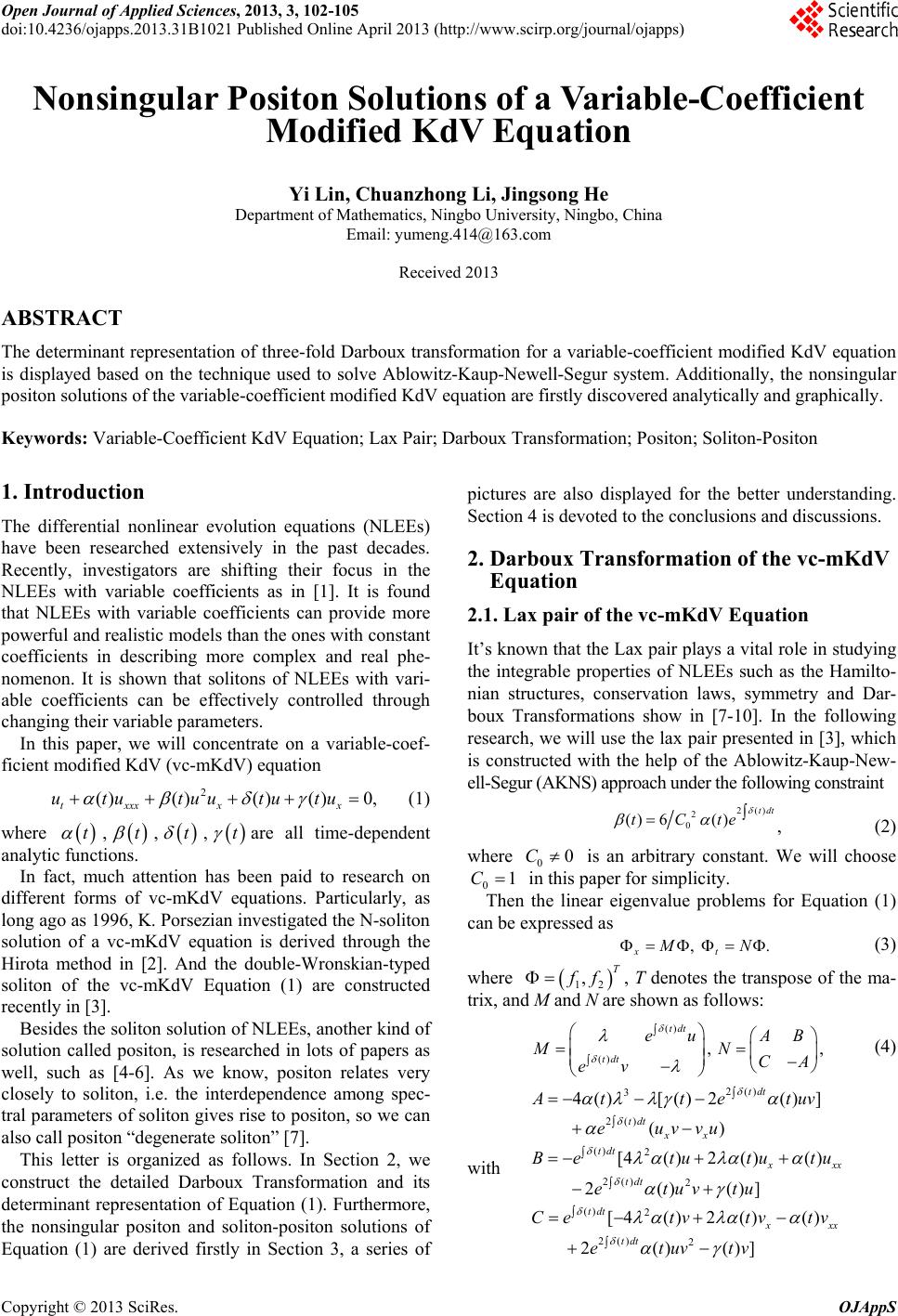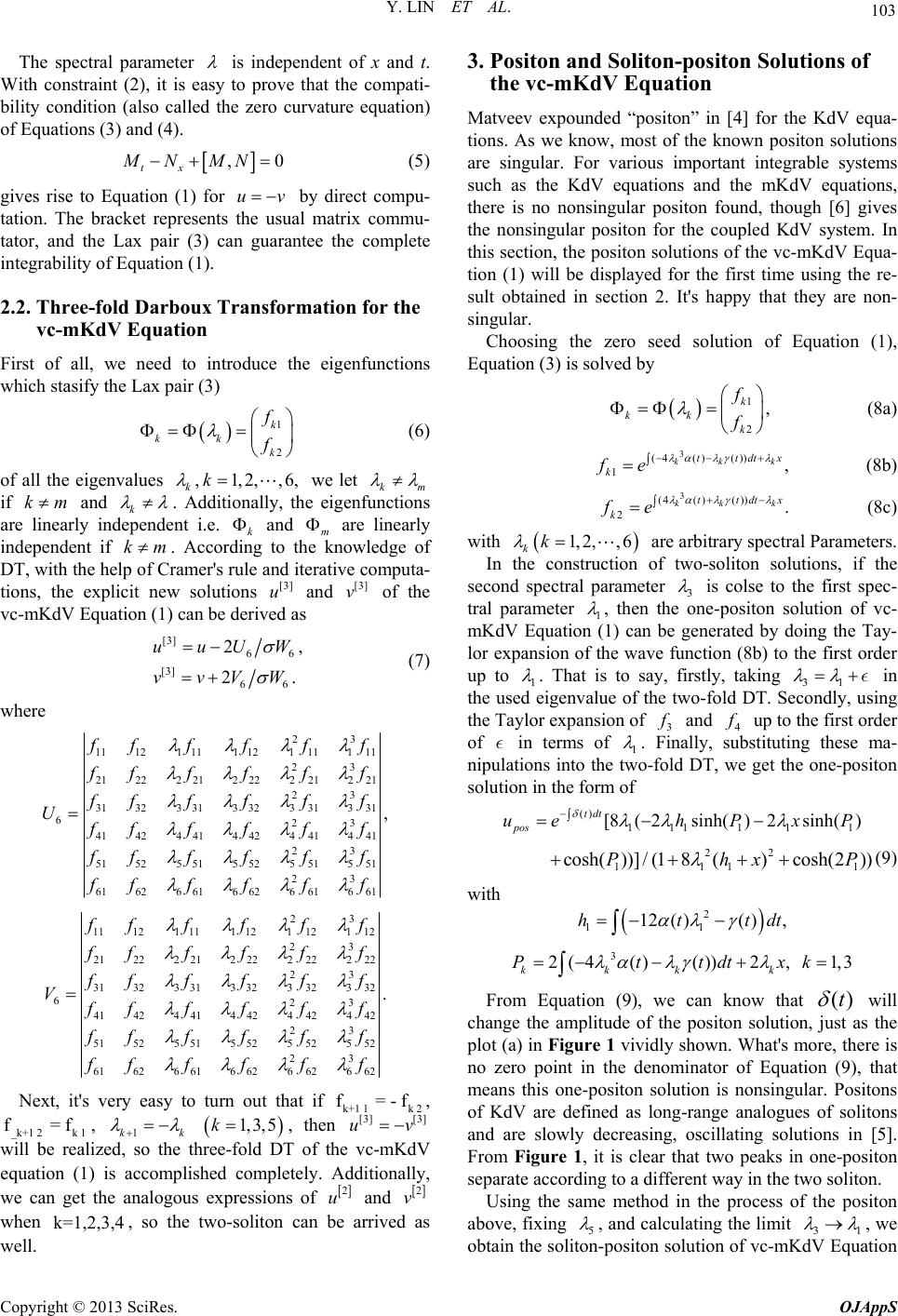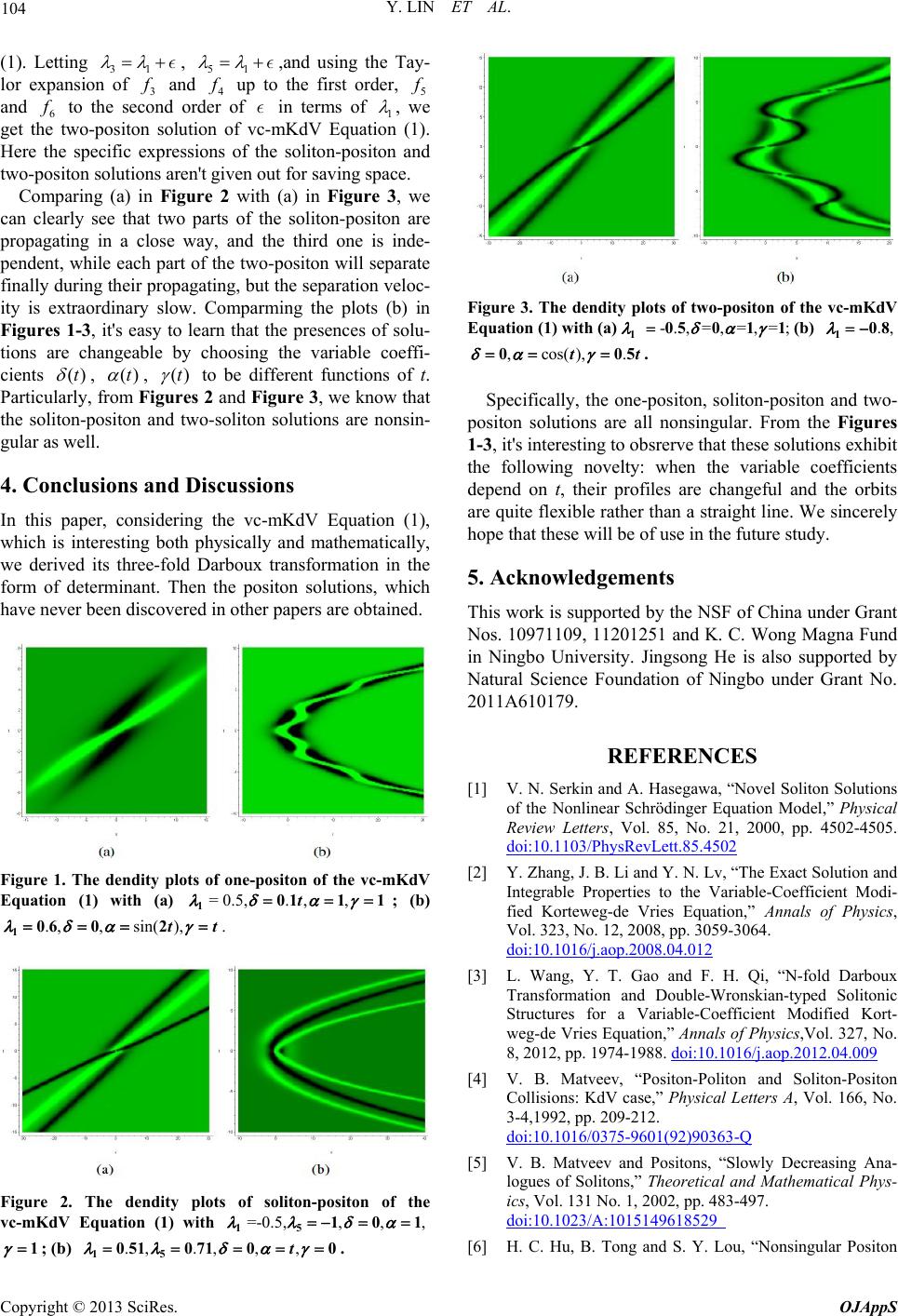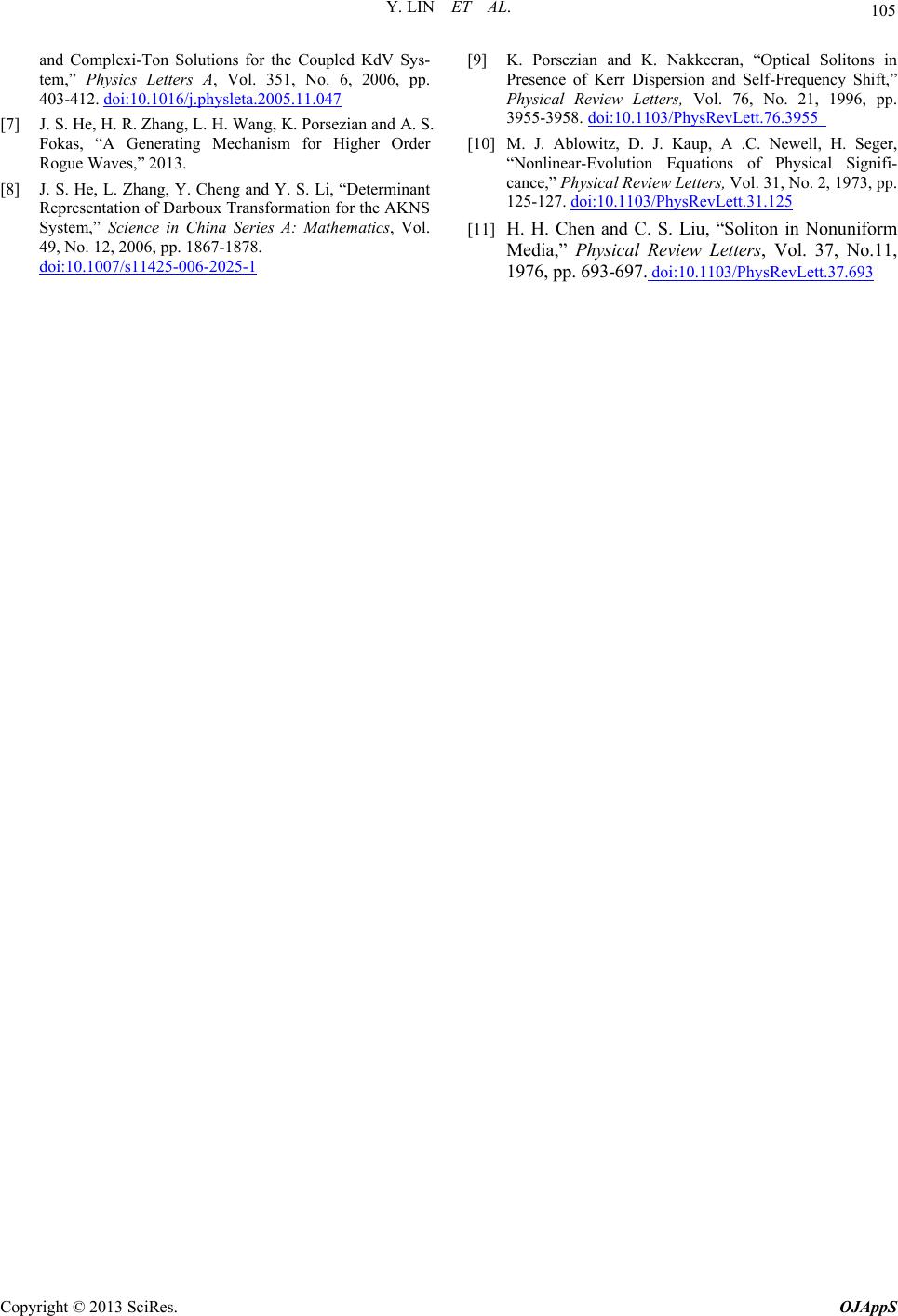 Open Journal of Applied Sciences, 2013, 3, 102-105 doi:10.4236/ojapps.2013.31B1021 Published Online April 2013 (http://www.scirp.org/journal/ojapps) Nonsingular Positon Solutions of a Variable-Coefficient Modified KdV Equation Yi Lin, Chuanzhong Li, Jingsong He Department of Mathematics, Ningbo University, Ningbo, China Email: yumeng.414@163.com Received 2013 ABSTRACT The determinant representation of three-fold Darboux transformation for a variable-coefficient modified KdV equation is displayed based on the technique used to solve Ablowitz-Kaup-Newell-Segur system. Additionally, the nonsingular positon solutions of the variable-coefficient modified KdV equation are firstly discovered analytically and graphically. Keywords: Variable-Coefficient KdV Equation; Lax Pair; Darboux Transformation; Positon; Soliton-Positon 1. Introduction The differential nonlinear evolution equations (NLEEs) have been researched extensively in the past decades. Recently, investigators are shifting their focus in the NLEEs with variable coefficients as in [1]. It is found that NLEEs with variable coefficients can provide more powerful and realistic models than the ones with constant coefficients in describing more complex and real phe- nomenon. It is shown that solitons of NLEEs with vari- able coefficients can be effectively controlled through changing their variable parameters. In this paper, we will concentrate on a variable-coef- ficient modified KdV (vc-mKdV) equation 2 ()()()() 0, t xxxxx ututuutu tu (1) where ,, , t t t t are all time-dependent analytic functions. In fact, much attention has been paid to research on different forms of vc-mKdV equations. Particularly, as long ago as 1996, K. Porsezian investigated the N-soliton solution of a vc-mKdV equation is derived through the Hirota method in [2]. And the double-Wronskian-typed soliton of the vc-mKdV Equation (1) are constructed recently in [3]. Besides the soliton solution of NLEEs, another kind of solution called positon, is researched in lots of papers as well, such as [4-6]. As we know, positon relates very closely to soliton, i.e. the interdependence among spec- tral parameters of soliton gives rise to positon, so we can also call positon “degenerate soliton” [7]. This letter is organized as follows. In Section 2, we construct the detailed Darboux Transformation and its determinant representation of Equation (1). Furthermore, the nonsingular positon and soliton-positon solutions of Equation (1) are derived firstly in Section 3, a series of pictures are also displayed for the better understanding. Section 4 is devoted to the conclusions and discussions. 2. Darboux Transformation of the vc-mKdV Equation 2.1. Lax pair of the vc-mKdV Equation It’s known that the Lax pair plays a vital role in studying the integrable properties of NLEEs such as the Hamilto- nian structures, conservation laws, symmetry and Dar- boux Transformations show in [7-10]. In the following research, we will use the lax pair presented in [3], which is constructed with the help of the Ablowitz-Kaup-New- ell-Segur (AKNS) approach under the following constraint 2() 2 0 () 6()tdt tCte , (2) where 00C is an arbitrary constant. We will choose 01C in this paper for simplicity. Then the linear eigenvalue problems for Equation (1) can be expressed as , . xt N (3) where 12 ,T f , T denotes the transpose of the ma- trix, and M and N are shown as follows: () () , , tdt tdt eu AB MN CA ev (4) with 2() 3 2() () 2 2() 2 () 2 2() 2 4()[() 2()] () [4()2( )( ) 2()()] [4()2 ()() 2()() tdt tdt xx tdt xx tdt tdt xx tdt Atte tuv euvvu etutu etuvtu C etvtvtv etuvt ]v tu Copyright © 2013 SciRes. OJAppS  Y. LIN ET AL. 103 The spectral parameter is independent of x and t. With constraint (2), it is easy to prove that the compati- bility condition (also called the zero curvature equation) of Equations (3) and (4). , tx MN MN 0 (5) gives rise to Equation (1) for by direct compu- tation. The bracket represents the usual matrix commu- tator, and the Lax pair (3) can guarantee the complete integrability of Equation (1). uv 2.2. Three-fold Darboux Transformation for the vc-mKdV Equation First of all, we need to introduce the eigenfunctions which stasify the Lax pair (3) 1 2 k kk k (6) of all the eigenvalues k , we let km 1, 2,, 6,k if and k km . Additionally, the eigenfunctions are linearly independent i.e. k and m are linearly independent if . According to the knowledge of DT, with the help of Cramer's rule and iterative computa- tions, the explicit new solutions and of the vc-mKdV Equation (1) can be derived as km [3] u[3 v] [3] 66 [3] 66 2, 2. uuUW vvVW (7) where 23 11121 111 12111111 23 21222 212 22221221 23 3132 331 332 331331 623 41424 414 42441441 23 51525 515 52551551 23 61626 616 62661661 , fff ff fffff fff ff U fffff fff ff fff ff 23 11121 111 12112112 23 2122 221222222 222 23 31323 313 32332332 623 4142 441442442 442 23 51525 515 52552552 23 6162 661662 662 662 . ffff f fff ff fff ff V fff ff fff ff fff ff Next, it's very easy to turn out that if , , k+1 1k 2 f = - f _k+1 2k 1 f = f1kk , then 1, 3, 5k[3][3] uv 2 u 2 v will be realized, so the three-fold DT of the vc-mKdV equation (1) is accomplished completely. Additionally, we can get the analogous expressions of and when , so the two-soliton can be arrived as well. k=1,2,3,4 3. Positon and Soliton-positon Solutions of the vc-mKdV Equation Matveev expounded “positon” in [4] for the KdV equa- tions. As we know, most of the known positon solutions are singular. For various important integrable systems such as the KdV equations and the mKdV equations, there is no nonsingular positon found, though [6] gives the nonsingular positon for the coupled KdV system. In this section, the positon solutions of the vc-mKdV Equa- tion (1) will be displayed for the first time using the re- sult obtained in section 2. It's happy that they are non- singular. Choosing the zero seed solution of Equation (1), Equation (3) is solved by 1 2 , k kk k f f (8a) 3 ( 4()()) 1, kk k ttdtx k fe (8b) 3 (4()()) 2. kk k ttdtx k fe (8c) with 1, 2,, 6 kk are arbitrary spectral Parameters. In the construction of two-soliton solutions, if the second spectral parameter 3 is colse to the first spec- tral parameter 1 , then the one-positon solution of vc- mKdV Equation (1) can be generated by doing the Tay- lor expansion of the wave function (8b) to the first order up to 1 . That is to say, firstly, taking 31 in the used eigenvalue of the two-fold DT. Secondly, using the Taylor expansion of 3 and 4 up to the first order of in terms of 1 . Finally, substituting these ma- nipulations into the two-fold DT, we get the one-positon solution in the form of () 1111 11 [8 (2sinh( )2sinh( ) tdt pos ueh PxP 22 111 cosh())] /(18()cosh(2)) 1 hx P (9) with 2 11 12 ()(),htt dt k 3 2(4()())2, 1,3 kkkk Ptttxd From Equation (9), we can know that ()t will change the amplitude of the positon solution, just as the plot (a) in Figure 1 vividly shown. What's more, there is no zero point in the denominator of Equation (9), that means this one-positon solution is nonsingular. Positons of KdV are defined as long-range analogues of solitons and are slowly decreasing, oscillating solutions in [5]. From Figure 1, it is clear that two peaks in one-positon separate according to a different way in the two soliton. Using the same method in the process of the positon above, fixing 5 , and calculating the limit 31 , we obtain the soliton-positon solution of vc-mKdV Equation Copyright © 2013 SciRes. OJAppS  Y. LIN ET AL. 104 (1). Letting 31 , 51 ,and using the Tay- lor expansion of 3 and 4 up to the first order, 5 and 6 to the second order of in terms of 1 , we get the two-positon solution of vc-mKdV Equation (1). Here the specific expressions of the soliton-positon and two-positon solutions aren't given out for saving space. Comparing (a) in Figure 2 with (a) in Figure 3, we can clearly see that two parts of the soliton-positon are propagating in a close way, and the third one is inde- pendent, while each part of the two-positon will separate finally during their propagating, but the separation veloc- ity is extraordinary slow. Comparming the plots (b) in Figures 1-3, it's easy to learn that the presences of solu- tions are changeable by choosing the variable coeffi- cients ()t , ()t , ()t to be different functions of t. Particularly, from Figures 2 and Figure 3, we know that the soliton-positon and two-soliton solutions are nonsin- gular as well. 4. Conclusions and Discussions In this paper, considering the vc-mKdV Equation (1), which is interesting both physically and mathematically, we derived its three-fold Darboux transformation in the form of determinant. Then the positon solutions, which have never been discovered in other papers are obtained. Figure 1. The dendity plots of one-positon of the vc-mKdV Equation (1) with (a) = 0.5, 1. ,,011t1 ; (b) .,06 ,sin( ),0 2 1tt . Figure 2. The dendity plots of soliton-positon of the vc-mKdV Equation (1) with =-0.5 1, 5 ,1,,10 1 ; (b) ., ., 15 051071,,0 0t . Figure 3. The dendity plots of two-positon of the vc-mKdV Equation (1) with (a) -.,=,=,=; 10501 1 (b) ., 108 ,cos(), .005tt . Specifically, the one-positon, soliton-positon and two- positon solutions are all nonsingular. From the Figures 1-3, it's interesting to obsrerve that these solutions exhibit the following novelty: when the variable coefficients depend on t, their profiles are changeful and the orbits are quite flexible rather than a straight line. We sincerely hope that these will be of use in the future study. 5. Acknowledgements This work is supported by the NSF of China under Grant Nos. 10971109, 11201251 and K. C. Wong Magna Fund in Ningbo University. Jingsong He is also supported by Natural Science Foundation of Ningbo under Grant No. 2011A610179. REFERENCES [1] V. N. Serkin and A. Hasegawa, “Novel Soliton Solutions of the Nonlinear Schrödinger Equation Model,” Physical Review Letters, Vol. 85, No. 21, 2000, pp. 4502-4505. doi:10.1103/PhysRevLett.85.4502 [2] Y. Zhang, J. B. Li and Y. N. Lv, “The Exact Solution and Integrable Properties to the Variable-Coefficient Modi- fied Korteweg-de Vries Equation,” Annals of Physics, Vol. 323, No. 12, 2008, pp. 3059-3064. doi:10.1016/j.aop.2008.04.012 [3] L. Wang, Y. T. Gao and F. H. Qi, “N-fold Darboux Transformation and Double-Wronskian-typed Solitonic Structures for a Variable-Coefficient Modified Kort- weg-de Vries Equation,” Annals of Physics,Vol. 327, No. 8, 2012, pp. 1974-1988. doi:10.1016/j.aop.2012.04.009 [4] V. B. Matveev, “Positon-Politon and Soliton-Positon Collisions: KdV case,” Physical Letters A, Vol. 166, No. 3-4,1992, pp. 209-212. doi:10.1016/0375-9601(92)90363-Q [5] V. B. Matveev and Positons, “Slowly Decreasing Ana- logues of Solitons,” Theoretical and Mathematical Phys- ics, Vol. 131 No. 1, 2002, pp. 483-497. doi:10.1023/A:1015149618529 [6] H. C. Hu, B. Tong and S. Y. Lou, “Nonsingular Positon Copyright © 2013 SciRes. OJAppS  Y. LIN ET AL. Copyright © 2013 SciRes. OJAppS 105 and Complexi-Ton Solutions for the Coupled KdV Sys- tem,” Physics Letters A, Vol. 351, No. 6, 2006, pp. 403-412. doi:10.1016/j.physleta.2005.11.047 [7] J. S. He, H. R. Zhang, L. H. Wang, K. Porsezian and A. S. Fokas, “A Generating Mechanism for Higher Order Rogue Waves,” 2013. [8] J. S. He, L. Zhang, Y. Cheng and Y. S. Li, “Determinant Representation of Darboux Transformation for the AKNS System,” Science in China Series A: Mathematics, Vol. 49, No. 12, 2006, pp. 1867-1878. doi:10.1007/s11425-006-2025-1 [9] K. Porsezian and K. Nakkeeran, “Optical Solitons in Presence of Kerr Dispersion and Self-Frequency Shift,” Physical Review Letters, Vol. 76, No. 21, 1996, pp. 3955-3958. doi:10.1103/PhysRevLett.76.3955 [10] M. J. Ablowitz, D. J. Kaup, A .C. Newell, H. Seger, “Nonlinear-Evolution Equations of Physical Signifi- cance,” Physical Review Letters, Vol. 31, No. 2, 1973, pp. 125-127. doi:10.1103/PhysRevLett.31.125 [11] H. H. Chen and C. S. Liu, “Soliton in Nonuniform Media,” Physical Review Letters, Vol. 37, No.11, 1976, pp. 693-697. doi:10.1103/PhysRevLett.37.693
|